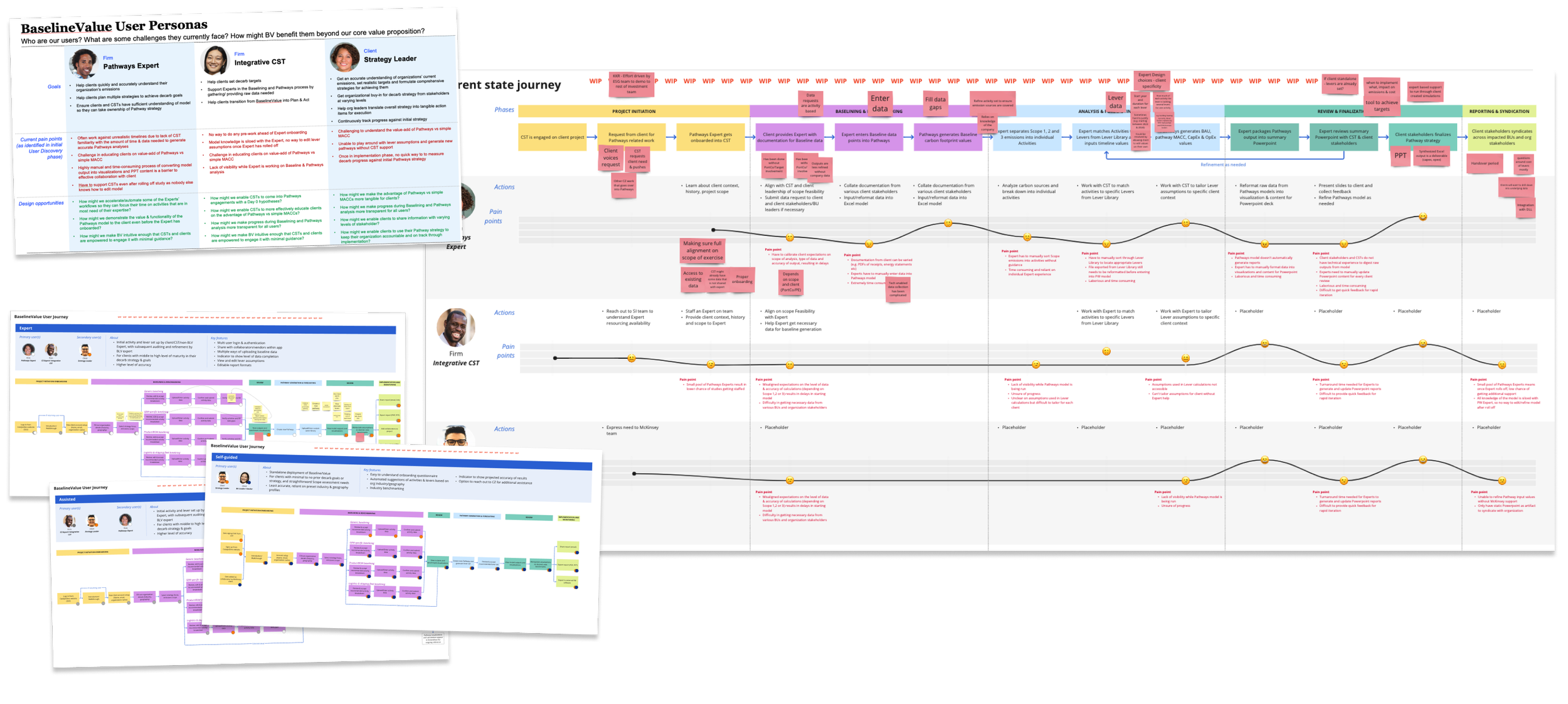Catalyst Zero
0-1 product strategy & design of B2B platform for GHG emissions accounting & decarbonization planning
CLIENT
McKinsey Sustainability, a division of the company dedicated to serving clients across industries on end-to-end decarbonization efforts.
IMPACT
0-1 MVP product definition, strategy and design
Enabled Sustainability team to complete 1.5x more client engagements vs prior year
Successful standalone deployment at multiple clients, with positive feedback:
“This tool looks really good and simple to understand! It will be critical as we expand decarbonization across our product portfolio”
“We never had this level of transparency on our CO2 reduction efforts... Until now”
“Impressed by the fundamental technical support this tool provides to help enhance our Scope 3 transparency”
TEAM/ROLE
Product Design Lead (myself) + Product Owner, Junior UI Designer, Tech Lead, Full Stack Dev team
RESPONSIBILITIES
As Design Lead, the scope of my work covered:
Workstream scoping, planning and management
Leading qualitative user research and testing, both concept and usability
Generating feature backlog based on North Star user journeys
Supporting Product Owner in MVP feature prioritization
Defining user flows & wireframes for MVP features
UI development; extending McKinsey’s existing design system to build a pattern library specific to the use cases of Sustainability group’s products and use cases
Design documentation (redlines, prototypes, annotated files) & support for F/E development
Sprint demos and presentations to Executive Leadership
Day-to-day creative direction and management of junior designer
Context
The client work done by McKinsey’s Sustainability group focuses on:
Helping clients audit the carbon impact of their entire value chain
Proposing potential pathways and timelines to Net Zero emissions, either by eliminating or replacing elements of the value chain.
This work hinges on 2 proprietary assets:
A database of emissions details for 1000+ manufacturing, logistics and operational processes
A dynamic model that uses those emissions details as inputs to calculate current baseline emissions and generate a timeline and emissions projection towards Net Zero
Problem/Brief
While the emissions database was digitalized in the form of an online library, the accounting and forecasting model was built in the form of an Excel workbook. This posed multiple challenges:
Emissions values from the online library had to be downloaded and manually input into the Excel document - these can number into the hundreds for a single client, which made the process arduous and prone to human error
Time-consuming for analysts to convert raw model outputs into visualizations, especially when forecasting multiple decarbonization pathways for comparison
Excel document required deep knowledge and experience, was difficult to onboard new analysts and impossible for external clients to use as a standalone tool
The starting brief called for a desktop app that could be used on engagements by McKinsey analysts and as a standalone app by external clients.
Screenshot of the Excel workbook that would eventually be replaced by the new tool.
Kicking off the Discovery phase
AKA: “Which scope of emissions is this again?”
My aims going into the Discovery phase were to:
get a deeper understanding of the current landscape carbon accounting and greenhouse gas (GHG) emissions
to understand the needs, pain points and current experience of target users
obtain a functional knowledge of how to use the Excel-based accounting and forecasting model
While I considered myself relatively aware of how greenhouse gases and their impacts, using the carbon accounting model required more detailed knowledge of the carbon accounting methodology outlined in the United Nations‘ GHG protocol and the decarbonization framework set out in the Paris Climate Accords. Google, Wikipedia, and days of interviews with SMEs and target users, helped me to accelerate my understanding of the user, subject matter and current state experience.
The current state journeys were used to build a North Star user journey, which served as main input for a feature ideation workshop with SMEs and Product Leadership. I refined the workshop outputs into an initial feature backlog which, together with the PO and Tech Lead, was then further developed, sized and prioritized down to an initial MVP scope.
Putting the M back in MVP
AKA: “When everything’s a priority, nothing is”
One of the hallmarks of designing a product from scratch is the lack of precedent - this makes it exciting to imagine a brand new experience, but can also make it challenging to describe/define what new features might look like. In the case of this project, some challenges we faced were:
The use cases being discussed were novel enough that business users found it difficult to envision it in adequate detail
User stories and feature descriptions weren’t granular enough for the development team to adequately size the build effort
This resulted in a bloated “MVP” feature list after our initial round of prioritization. To address this, I spent a sprint mocking up screens for the key features that were identified in the initial list - which helped facilitate a second round of feature prioritization that got us to a final, narrower MVP scope.
The video above is a demo I created of the North Star experience, and was shown at COP27 in Egypt as part of McKinsey’s sustainability exhibit.
Production-ready MVP design in 10 weeks
Working with a junior designer, we built wireframes and clickable prototypes to define MVP user experience. Throughout this process I conducted regular usability and content sessions with SMEs, target users, POs, tech & dev team to ensure a robust and buildable UX - while generating executive leadership excitement through weekly e-mail updates and presentations at biweekly sprint demos.














